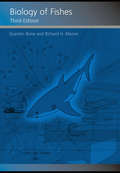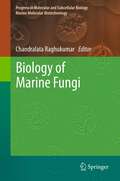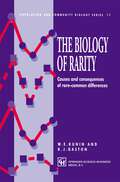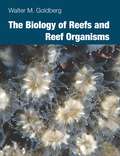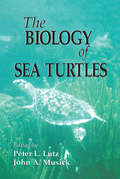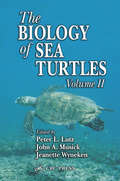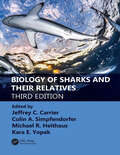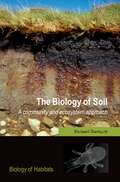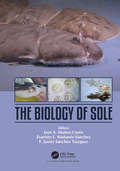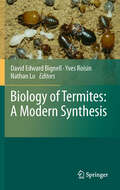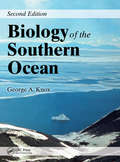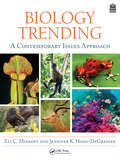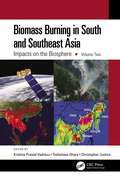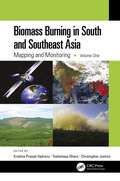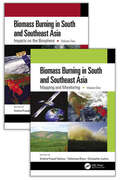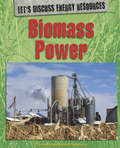- Table View
- List View
Biology of Fishes
by Quentin Bone Richard MooreThe VitalBook e-book version of Biology of Fishes is only available only in the US and Canada at the present time. To purchase or rent please visit http://store.vitalsource.com/show/978-1-1341-8631-0. The Third Edition of Biology of Fishes is chiefly about fish as remarkably efficient machines for coping with the many problems that life in wat
Biology of Fishes
by Richard Moore Quentin BoneThe VitalBook e-book version of Biology of Fishes is only available only in the US and Canada at the present time. To purchase or rent please visit http://store.vitalsource.com/show/978-1-1341-8631-0. The Third Edition of Biology of Fishes is chiefly about fish as remarkably efficient machines for coping with the many problems that life in wat
Biology of Marine Fungi (Progress in Molecular and Subcellular Biology #53)
by Chandralata RaghukumarChandralata RaghukumarThe diversity, ecological role and biotechnological applications of marine fungi have been addressed in numerous scientific publications in the last few years. This enormous spurt of information has led to a dire need among students and professionals alike for a source, which contains comprehensive reviews of various aspects of marine fungi. This book addresses this need, especially since it is written by reputed marine mycologists. The latest information on topics including molecular taxonomy and phylogeny, ecology of fungi in different marine habitats such as deep sea, corals, dead- sea, fungi in extreme marine environments and their biotechnological applications is reviewed. The book presents a comprehensive source of information and analysis aimed at marine fungi for researchers, teachers and students of marine mycology.
The Biology of Rarity: Causes and consequences of rare—common differences (Population and Community Biology Series #17)
by Kevin J. Gaston William E. KuninThis book began life as a review article. That article spawned a symposium which was, in turn, greatly expanded to form the present volume. As the project moved through these developmental stages (hopefully, towards attainment of its full maturity), a number of people have provided invaluable assistance to us, and we would like to take this opportunity to thank them. Gordon Orians must certainly take a high place in that list. He has been both a friend and mentor to W.E.K., and many of the topics explored in this book have emerged from the resultant dialogue. His thought processes, ideas and perhaps even some of his turns of phrase emerge throughout much ofthe book. Gordon also played a pivotal role in inviting in motion, and so he has served as a catalyst the article that set this project to the book as well as one of its reagents. While he has not served as an editor of this book, he is one of its authors in more than just the literal sense.
The Biology of Reefs and Reef Organisms
by Walter M. GoldbergReefs provide a wealth of opportunity for learning about biological and ecosystem processes, and reef biology courses are among the most popular in marine biology and zoology departments the world over. Walter M. Goldberg has taught one such course for years, and he marshals that experience in the pages of The Biology of Reefs and Reef Organisms. Goldberg examines the nature not only of coral reefs—the best known among types of reefs—but also of sponge reefs, worm reefs, and oyster reefs, explaining the factors that influence their growth, distribution, and structure. A central focus of the book is reef construction, and Goldberg details the plants and animals that form the scaffold of the reef system and allow for the attachment and growth of other organisms, including those that function as bafflers, binders, and cementing agents. He also tours readers through reef ecology, paleontology, and biogeography, all of which serve as background for the problems reefs face today and the challenge of their conservation. Visually impressive, profusely illustrated, and easy to read, The Biology of Reefs and Reef Organisms offers a fascinating introduction to reef science and will appeal to students and instructors of marine biology, comparative zoology, and oceanography.
The Biology of Sea Turtles, Volume I (CRC Marine Science #12)
by Peter L. Lutz John A. MusickSea turtles have existed for millions of years, making them fascinating subjects of study. In the last 20 years, the science of sea turtle biology has expanded at an exponential rate, leading to major advances in many areas. This book synthesizes the results of these advances and focuses on how these endangered marine reptiles operate in, adapt to, and are dependent upon particular features of their marine environment. New technology in data gathering, such as DNA analyses, remote sensing, and physiological monitoring techniques, has led to a much greater understanding of the biology of the sea turtle at all stages of their life history.
The Biology of Sea Turtles, Volume I (CRC Marine Science #12)
by Peter L. Lutz John A. MusickSea turtles have existed for millions of years, making them fascinating subjects of study. In the last 20 years, the science of sea turtle biology has expanded at an exponential rate, leading to major advances in many areas. This book synthesizes the results of these advances and focuses on how these endangered marine reptiles operate in, adapt to, and are dependent upon particular features of their marine environment. New technology in data gathering, such as DNA analyses, remote sensing, and physiological monitoring techniques, has led to a much greater understanding of the biology of the sea turtle at all stages of their life history.
The Biology of Sea Turtles, Volume II
by Peter L. Lutz John A. Musick Jeanette WynekenThe success of the first volume of The Biology of Sea Turtles revealed a need for broad but comprehensive reviews of major recent advances in sea turtle biology. Biology of Sea Turtles, Volume II emphasizes practical aspects of biology that relate to sea turtle management and to changes in marine and coastal ecosystems. These topics i
Biology of Sharks and Their Relatives (CRC Marine Biology Series)
by Jeffrey C. Carrier Colin A. Simpfendorfer Michael R. Heithaus Kara E. YopakBiology of Sharks and Their Relatives is an award-winning and groundbreaking exploration of the fundamental elements of the taxonomy, systematics, physiology, and ecology of sharks, skates, rays, and chimera. This edition presents current research as well as traditional models, to provide future researchers with solid historical foundations in shark research as well as presenting current trends from which to develop new frontiers in their own work. Traditional areas of study such as age and growth, reproduction, taxonomy and systematics, sensory biology, and ecology are updated with contemporary research that incorporates emerging techniques including molecular genetics, exploratory techniques in artificial insemination, and the rapidly expanding fields of satellite tracking, remote sensing, accelerometry, and imaging. With two new editors and 90 contributors from the US, UK, South Africa, Portugal, France, Canada, New Zealand, Australia, India, Palau, United Arab Emirates, Micronesia, Sweden, Argentina, Indonesia, Cameroon, and the Netherlands, this third edition is the most global and comprehensive yet. It adds six new chapters representing extensive studies of health, stress, disease and pathology, and social structure, and continues to explore elasmobranch ecological roles and interactions with their habitats. The book concludes with a comprehensive review of conservation policies, management, and strategies, as well as consideration of the potential effects of impending climate change. Presenting cohesive and integrated coverage of key topics and discussing technological advances used in modern shark research, this revised edition offers a well-rounded picture for students and researchers.
Biology of Sharks and Their Relatives (CRC Marine Biology Series)
by Jeffrey C. Carrier Colin A. Simpfendorfer Michael R. Heithaus Kara E. YopakBiology of Sharks and Their Relatives is an award-winning and groundbreaking exploration of the fundamental elements of the taxonomy, systematics, physiology, and ecology of sharks, skates, rays, and chimera. This edition presents current research as well as traditional models, to provide future researchers with solid historical foundations in shark research as well as presenting current trends from which to develop new frontiers in their own work. Traditional areas of study such as age and growth, reproduction, taxonomy and systematics, sensory biology, and ecology are updated with contemporary research that incorporates emerging techniques including molecular genetics, exploratory techniques in artificial insemination, and the rapidly expanding fields of satellite tracking, remote sensing, accelerometry, and imaging. With two new editors and 90 contributors from the US, UK, South Africa, Portugal, France, Canada, New Zealand, Australia, India, Palau, United Arab Emirates, Micronesia, Sweden, Argentina, Indonesia, Cameroon, and the Netherlands, this third edition is the most global and comprehensive yet. It adds six new chapters representing extensive studies of health, stress, disease and pathology, and social structure, and continues to explore elasmobranch ecological roles and interactions with their habitats. The book concludes with a comprehensive review of conservation policies, management, and strategies, as well as consideration of the potential effects of impending climate change. Presenting cohesive and integrated coverage of key topics and discussing technological advances used in modern shark research, this revised edition offers a well-rounded picture for students and researchers.
The Biology of Soil: A community and ecosystem approach (Biology of Habitats)
by Richard BardgettThis book is unique in providing a comprehensive, up-to-date synthesis of what is known about soil biodiversity and the factors that regulate its distribution, as well as the functional significance of below-ground biodiversity for ecosystem form and function. It describes the vast diversity of biota that live in the soil environment - the most complex habitat on Earth - and discusses the factors that act as determinants of this diversity across different spatial and temporal scales. The Biology of Soil also considers how biotic interactions in soil influence the important soil processes of decomposition and nutrient cycling . It demonstrates how interactions and feedbacks between diverse plant and soil communities act as important drivers of ecosystem form and function. The importance of these relationships for understanding how ecosystems respond to global change phenomena, including climate change, is discussed in depth. Much is still to be learned about the soil biota and their roles in ecosystems, and the author highlights some of the many challenges that face ecologists in the exploration of soil. Richard Bardgett has wide experience in soil and terrestrial ecology, and his background of research in many ecosystems is reflected in this book which is the most comprehensive, up-to-date volume currently available in soil ecology. It provides an introduction to the biology of soil, and it also discusses the most recent developments in this progressive field of ecology. The importance of soil biotic interactions for community and ecosystem ecology is illustrated through the use of numerous examples and case studies. The Biology of Soil provides an excellent, easy to read introduction for anyone working in the field of soil ecology and related disciplines, and will be ideal for students taking undergraduate and postgraduate courses in soil ecology, plant-soil relationships, ecosystem ecology, and land management.
The Biology of Sole
by José A. Munoz-Cueto Evaristo Mañanós-Sánchez F. Javier Sánchez-VázquezThis book reviews up-to-date knowledge on the biology of sole (Solea senegalensis and S. solea). These flatfish species are increasingly important in Europe both from the ecological and production point of view. This book is divided into two sections: A. general fisheries, aquaculture and engineering overviews; B. physiological, developmental, rhythmic, welfare and genetic aspects which will be of immense interest for the aquaculture industry. Experts, from both academia and research institutes, provide their expertise on sole biology.
The Biology of Sole
by Jose A. Muñoz-Cueto F. Javier Sánchez-Vázquez F. Javier Sanchez Vazquez Evaristo Mañanós-SánchezThis book reviews up-to-date knowledge on the biology of sole (Solea senegalensis and S. solea). These flatfish species are increasingly important in Europe both from the ecological and production point of view. This book is divided into two sections: A. general fisheries, aquaculture and engineering overviews; B. physiological, developmental, rhythmic, welfare and genetic aspects which will be of immense interest for the aquaculture industry. Experts, from both academia and research institutes, provide their expertise on sole biology.
Biology of Termites: a Modern Synthesis
by David Edward Edward Bignell, Yves Roisin and Nathan LoBiology of Termites, a Modern Synthesis brings together the major advances in termite biology, phylogenetics, social evolution and biogeography. In this new volume, David Bignell, Yves Roisin and Nathan Lo have brought together leading experts on termite taxonomy, behaviour, genetics, caste differentiation, physiology, microbiology, mound architecture, biogeography and control. Very strong evolutionary and developmental themes run through the individual chapters, fed by new data streams from molecular sequencing, and for the first time it is possible to compare the social organisation of termites with that of the social Hymenoptera, focusing on caste determination, population genetics, cooperative behaviour, nest hygiene and symbioses with microorganisms. New chapters have been added on termite pheromones, termites as pests of agriculture and on destructive invasive species.
Biology of the Southern Ocean
by George A. KnoxFirst published in 1993, The Biology of the Southern Ocean has been referred to as international research at its best and an invaluable reference. Drawing on the considerable volume of information published in the last ten years, this second edition retains the format that made the first edition a popular bestseller, while updating the information
Biology Trending: A Contemporary Issues Approach
by Eli Minkoff Jennifer K. Hood-DeGrenierBiology Trending is a truly innovative introductory biology text. Designed to combine the teaching of biological concepts within the context of current societal issues, Biology Trending encourages introductory biology students to think critically about the role that science plays in their world. This book features many current and relevant topics, including sea-level changes and ocean acidification; CRISPR/Cas9, opioid abuse, Zika, Ebola, and COVID-19; threats to biodiversity, and cancer immunotherapies. It is accompanied by digital Instructor and Student Resources to support teaching and learning.Key Features Adopts an "issues approach" to teaching introductory biology Up-to-date sections throughout, including climate change, CRISPR, new hominids, COVID-19, and new cancer therapies, among many others Suitable for both major and nonmajor courses More succinct for ease in teaching and more affordable for students High-quality illustrations help to elucidate key concepts This book is extended and enhanced through a range of digital resources that include: Long-form and open-response self-testing resources to test understanding and apply knowledge Visual simulations to demonstrate evolutionary processes Web links and bibliographic resources to expand knowledge Time-saving instructor resources such as PowerPoint slides, activity and assignment ideas, and comprehensive lesson plans Related TitlesBard, J. Evolution: The Origins and Mechanisms of Diversity (ISBN 9780367357016).Prothero, D. Vertebrate Evolution: From Origins to Dinosaurs and Beyond (ISBN 9780367473167)Johnson, N. A. Darwin’s Reach: 21st Century Applications of Evolutionary Biology (ISBN 9781138587397)
Biology Trending: A Contemporary Issues Approach
by Eli Minkoff Jennifer K. Hood-DeGrenierBiology Trending is a truly innovative introductory biology text. Designed to combine the teaching of biological concepts within the context of current societal issues, Biology Trending encourages introductory biology students to think critically about the role that science plays in their world. This book features many current and relevant topics, including sea-level changes and ocean acidification; CRISPR/Cas9, opioid abuse, Zika, Ebola, and COVID-19; threats to biodiversity, and cancer immunotherapies. It is accompanied by digital Instructor and Student Resources to support teaching and learning.Key Features Adopts an "issues approach" to teaching introductory biology Up-to-date sections throughout, including climate change, CRISPR, new hominids, COVID-19, and new cancer therapies, among many others Suitable for both major and nonmajor courses More succinct for ease in teaching and more affordable for students High-quality illustrations help to elucidate key concepts This book is extended and enhanced through a range of digital resources that include: Long-form and open-response self-testing resources to test understanding and apply knowledge Visual simulations to demonstrate evolutionary processes Web links and bibliographic resources to expand knowledge Time-saving instructor resources such as PowerPoint slides, activity and assignment ideas, and comprehensive lesson plans Related TitlesBard, J. Evolution: The Origins and Mechanisms of Diversity (ISBN 9780367357016).Prothero, D. Vertebrate Evolution: From Origins to Dinosaurs and Beyond (ISBN 9780367473167)Johnson, N. A. Darwin’s Reach: 21st Century Applications of Evolutionary Biology (ISBN 9781138587397)
Biomagnetism: An Interdisciplinary Approach
by Samuel J. Williamson Gian-Luca Romani Lloyd Kaufman Ivo ModenaBiomagnetism is the study of magnetic fields that originate in biological systems. This is a relatively new discipline that has attracted considerable interest throughout the scientific commu- ty. The study of biomagnetic fields requires the use of techniques and concepts drawn from widely disparate scientific disciplines. To make these techniques and concepts available to a wide spectrum of the scientific community, a NATO Advanced study Institute on B- magnetism was held near Frascati at Grottaferrata, Italy, in S- tember 1982. This volume is based on the lectures delivered by scholars representing many different scientific areas, ranging from solid state physics to psychology. It attempts to preserve the - herent development of concepts drawn from physiology, psychology, biology, physics, medicine, occupational health and geology that was evident during the Institute. The reader will quickly become aware that the progress in biomagnetism over the past decade was due principally to the efforts of interdisciplinary teams of sci- tists. One of the purposes of this volume is to make all of the basic principles and findings of biomagnetism available in one place, so that scientists who have already embarked on the study of biomagnetism or who plan to do so in the near future will have them available for study and reference. Each section of this volume was written by a recognized expert who lectured at the Institute on the topics he describes here.
Biomass Burning and Its Inter-Relationships with the Climate System (Advances in Global Change Research #3)
by John L. Innes Martin Beniston Michel M. VerstraeteJOHN L. INNES University of British Columbia, Vancouver, Canada The interactions between biomass burning and climate have been brought into focus by a number of recent events. Firstly, the Framework Convention on Climate Change and, more recently, the Kyoto Protocol, have drawn the attention of policy makers and others to the importance of biomass burning in relation to atmospheric carbon dioxide concentrations. Secondly, the use of prescribed fires has become a major management tool in some countries; with for example the area with fuel treatments (which include prescribed burns and mechanical treatments) having increased on US National Forest System lands from 123,000 ha in 1985 to 677,000 ha in 1998. Thirdly, large numbers of forest fires in Indonesia, Brazil, Australia and elsewhere in 1997 and 1998 received unprecedented media attention. Consequently, it is appropriate that one of the Wengen Workshops on Global Change Research be devoted to the relationships between biomass burning and climate. This volume includes many of the papers presented at the workshop, but is also intended to act as a contribution to the state of knowledge on the int- relationships between biomass burning and climate change. Previous volumes on biomass burning (e. g. Goldammer 1990,Levine 1991a, Crutzen and Goldammer 1993, Levine 1996a, 1996b, Van Wilgen et al. 1997) have stressed various aspects of the biomass–climate issue, and provide a history of the development of our understanding of the many complex relationships that are involved.
Biomass Burning in South and Southeast Asia: Impacts on the Biosphere, Volume Two
by Krishna Prasad Vadrevu Toshimasa Ohara Christopher JusticeBiomass burning is one of the most important sources of greenhouse gas emissions and aerosols in South and Southeast Asia and greatly impacts other countries through transboundary air pollution. With contributions from leading scientists, this volume offers an interdisciplinary perspective on the impacts of biomass burning on the land resources, climate, and the atmosphere. It showcases several examples linking top-down remote sensing, bottom-up ground-based measurements, and an integrated modeling to address the impacts of biomass burning and land–atmosphere interactions. It is a valuable guide for readers in atmospheric science, ecology, spatial geography, remote sensing, and GIS. This book is unique as it highlights the sources and the causes of biomass burning and atmospheric research in South and Southeast Asia. It explains the latest tools and techniques, in particular the use of satellite remote sensing and geospatial technologies for fire mapping, monitoring, and land cover/land use change. It focuses on large spatial scales integrating top-down and bottom-up methodologies. It addresses the pressing issues of air pollution rampant in South and Southeast Asia. It includes contributions from global experts working on biomass burning projects in the USA, Japan, South/Southeast Asia, and Europe. The contents of this book will appeal to students and professionals using remote sensing and geospatial techniques, including geographers, ecologists, atmospheric and environmental scientists, and all who are interested in biomass burning pollution.
Biomass Burning in South and Southeast Asia: Mapping and Monitoring, Volume One
by Krishna Prasad Vadrevu Toshimasa Ohara Christopher JusticeVolume 1 of a two volume set, this book is a self-contained, state-of-the-art analysis of remote sensing, ground-based, and spatial techniques used for characterizing biomass burning events and pollution. It is a collective achievement of renowned scientists working throughout South and Southeast Asia. They discuss the complexity of vegetation patterns, biomass characteristics, fire distribution, drivers of fires, and several examples of the use of novel satellite algorithms for mapping and monitoring biomass burning events. The book is highly interdisciplinary and integrates earth science and environmental science including ecology, fire science, spatial geography, remote sensing, and geospatial technologies. Unique in its discussion of the sources and the causes of biomass burning and atmospheric research in South and Southeast Asia. Explains how remote sensing and geospatial technologies help the mapping and monitoring of biomass burning events and their impacts. Focuses on large spatial scales integrating top-down and bottom-up methodologies. Addresses the pressing issues of environmental pollution that are rampant in South and Southeast Asia. Includes contributions from global experts actually working on biomass burning projects in the US, Japan, South/Southeast Asia, and Europe. This book will serve as a valuable source of information for remote sensing scientists, geographers, ecologists, atmospheric scientists, environmental scientists, and all who wish to advance their knowledge on fires and biomass burning in South/Southeast Asia.
Biomass Burning in South and Southeast Asia: Mapping and Monitoring, Volume One
by Krishna Prasad Vadrevu Toshimasa Ohara Christopher JusticeVolume 1 of a two volume set, this book is a self-contained, state-of-the-art analysis of remote sensing, ground-based, and spatial techniques used for characterizing biomass burning events and pollution. It is a collective achievement of renowned scientists working throughout South and Southeast Asia. They discuss the complexity of vegetation patterns, biomass characteristics, fire distribution, drivers of fires, and several examples of the use of novel satellite algorithms for mapping and monitoring biomass burning events. The book is highly interdisciplinary and integrates earth science and environmental science including ecology, fire science, spatial geography, remote sensing, and geospatial technologies. Unique in its discussion of the sources and the causes of biomass burning and atmospheric research in South and Southeast Asia. Explains how remote sensing and geospatial technologies help the mapping and monitoring of biomass burning events and their impacts. Focuses on large spatial scales integrating top-down and bottom-up methodologies. Addresses the pressing issues of environmental pollution that are rampant in South and Southeast Asia. Includes contributions from global experts actually working on biomass burning projects in the US, Japan, South/Southeast Asia, and Europe. This book will serve as a valuable source of information for remote sensing scientists, geographers, ecologists, atmospheric scientists, environmental scientists, and all who wish to advance their knowledge on fires and biomass burning in South/Southeast Asia.
Biomass Burning in South and Southeast Asia: Impacts on the Biosphere, Volume Two
by Krishna Prasad Vadrevu Toshimasa Ohara Christopher JusticeBiomass burning is one of the most important sources of greenhouse gas emissions and aerosols in South and Southeast Asia and greatly impacts other countries through transboundary air pollution. With contributions from leading scientists, this volume offers an interdisciplinary perspective on the impacts of biomass burning on the land resources, climate, and the atmosphere. It showcases several examples linking top-down remote sensing, bottom-up ground-based measurements, and an integrated modeling to address the impacts of biomass burning and land–atmosphere interactions. It is a valuable guide for readers in atmospheric science, ecology, spatial geography, remote sensing, and GIS. This book is unique as it highlights the sources and the causes of biomass burning and atmospheric research in South and Southeast Asia. It explains the latest tools and techniques, in particular the use of satellite remote sensing and geospatial technologies for fire mapping, monitoring, and land cover/land use change. It focuses on large spatial scales integrating top-down and bottom-up methodologies. It addresses the pressing issues of air pollution rampant in South and Southeast Asia. It includes contributions from global experts working on biomass burning projects in the USA, Japan, South/Southeast Asia, and Europe. The contents of this book will appeal to students and professionals using remote sensing and geospatial techniques, including geographers, ecologists, atmospheric and environmental scientists, and all who are interested in biomass burning pollution.
Biomass Burning in South and Southeast Asia, Two Volume Set
by Krishna Prasad Vadrevu Toshimasa Ohara Christopher JusticeThe increasing intensity and frequency of natural disasters all around the world has caused severe socioeconomic impacts, especially in South and Southeast Asia. This region is particularly susceptible to vegetation fires, leading to biomass burning pollution with impacts on other countries through trans-boundary air pollution. Despite the growing body of information on biomass pollutants worldwide, only a modest amount of data from these regions are available. With fires and biomass burning identified as a vital issue in South/Southeast Asia, this two-volume set was created to meet community research and application needs. To better serve the atmospheric, environmental, and remote sensing communities, and to address air quality, climate, and the human health impacts of greenhouse gases and aerosols from biomass burning, this set brings together the collective achievements of experts in these regions and the state-of-the-art technologies and spatial analyses to model and monitor biomass burning events and their impacts. This first volume covers various topics on fire, biomass burning, mapping and monitoring while the second volume highlights the impact of biomass burning on the biosphere and reflects extensive research by interdisciplinary teams of experts. This set will serve as a valuable resource for remote sensing scientist, geographers, ecologists, atmospheric scientists, environmental scientists, and all who wish to advance their knowledge on fires, biomass burning, and biomass burning pollution in South/Southeast Asia Specific Features: Unique in its discussion of the sources and the causes of biomass burning and atmospheric research in South and Southeast Asia. Explains how remote sensing and geospatial technologies help the mapping and monitoring of biomass burning events and their impacts. Focuses on large spatial scales integrating top-down and bottom-up methodologies. Addresses the pressing issues of environmental pollution that are rampant in South and Southeast Asia. Includes contributions from global experts currently working on biomass burning projects in the US, Japan, South/Southeast Asia, and Europe.
Biomass Power: Biomass Power Library Ebook (Let's Discuss Energy Resources #5)
by Richard Spilsbury Louise SpilsburyWith supplies of non-renewable energy sources running low and the threat of global warming and climate change, there is an urgent need to look at other types of energy resources and how well they can meet our power needs. While new technologies are being developed, each energy resource comes at a cost. This series looks at each energy resource, the technology and cost of how it is used to meet power needs and how it impacts the environment and humans. Each book explains how that power is generated and where it is used, and then, using specific Let's Discuss panels, explores the various advantages and disadvantages that concern it's use as an alternative fuel source. Case studies examine specific usage examples where that source has either worked or not worked so that the reader can weigh up the pros and cons for the use of each source against the alternatives.
